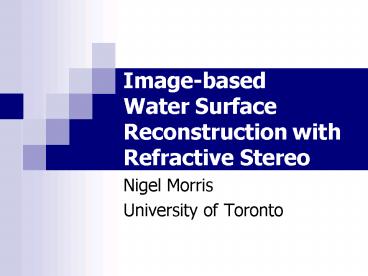Imagebased Water Surface Reconstruction with Refractive Stereo - PowerPoint PPT Presentation
Title:
Imagebased Water Surface Reconstruction with Refractive Stereo
Description:
Requires underwater lens, orthographic camera model. Goals of our system ... We use the second camera to determine the error ... Calibrated stereo camera system ... – PowerPoint PPT presentation
Number of Views:69
Avg rating:3.0/5.0
Title: Imagebased Water Surface Reconstruction with Refractive Stereo
1
Image-based Water Surface Reconstruction with
Refractive Stereo
- Nigel Morris
- University of Toronto
2
Motivation
- Computational Fluid Dynamics are extremely
complex and difficult to simulate - Why not capture fluid effects from reality?
- We present the first step to capturing fluids
from reality reconstructing water surfaces - May eventually be useful for determining fluid
flow
3
Previous Work
- Shape from shading Schultz94
- Requires large area light source or multiple
views - Shape from refractive distortion Murase90
- Limited wave amplitude, orthographic camera model
- Laser range finders Wu90
- Specialized equipment
4
Previous work
- Shape from refractive irradiance Jähne92,
Zhang94 Daida95 - Requires underwater lens, orthographic camera
model
5
Goals of our system
- Physically-consistent water surface
reconstruction - Reconstruction of rapid sequences of flowing,
shallow water - High reconstruction resolution
- Use of a minimal number of viewpoints and props
6
Technical Contributions
- We present a design for a stereo system for
capturing sequences of dynamic water - System implementation and results
- Refractive stereo matching metrics and analysis
- Effective localization of surface points of
shallow water
7
Refraction
- Snells Law
- r1sin Ti r2sin Tr
- For air ? water
- sin Ti rwsin Tr
8
Imaging water
- Image point f at q without water
- Image f at q with water
- qq is the refractive disparity
9
Deriving the surface normal
- Suppose we know the location of the surface point
p and its depth from the camera z - We know the angle ?d between the refracted rays u
and v - Can compute the incident angle ?i, then the
normal n
10
Solution space
- For given refractive disparity, set of solution
pairs - nmzm
- For every depth z, there is at most one normal n
11
Reconstruction with Stereo
- Same setup as with one camera, but with
additional calibrated camera - We search through the ltnmzmgt solution space for a
particular refractive disparity - We use the second camera to determine the error
for each instance of nmzm - Return best surface point p
12
Refractive stereo matching
Camera 2
Camera 1
n2
n1
n
Tank Bottom
13
Matching metric
- Normal collinearity metric
- Measure the angle between the two normals n1 and
n2 to give an error. - Disparity difference metric
- Swap n1 and n2 and reproject to tank plane,
measure disparity from the projection before
swapping. - Seeks to minimize error due to inaccurate normal
measurements as water depth approaches
localization error range.
14
Disparity Difference Metric
Camera 2
Camera 1
Tank Bottom
e1
e2
15
Metric Comparison
- Disparity difference metric in red
- Normal collinearity metric in blue
16
Implementation details
- Pattern choice
- Checkered pattern used
- Tracking pattern and localization
- Lucas-Kanade matching
- Interpolation of the discrete pattern
17
System Inputs
- Calibrated stereo camera system
- Images of pattern without water from both cameras
to give refractive disparities - Distorted pattern image sequences
18
Corner tracking
- In order to reconstruct a sequence of frames, the
corners must be localized at every frame - We employ a Lucas-Kanade matching technique,
matching templates of the corners to the next
frame
19
Corner Interpolation
- We cannot assume that our verification ray will
land on one of the corners - We thus find the four nearest non-collinear
corners - The surface may be distorted so we cannot assume
a grid formation - We interpolate between these corners to find the
distortion of the verification ray
20
Results
- Ripple Drop
- Waves
- Pouring water
21
Future Work
- Global surface minimization vs local
- Planar tank constraint removal
- More complex water scenario capturing
22
References
- Jähne92 B. Jähne, J. Klinke, P. Geissler, and
F. Hering. Image sequence analysis of ocean wind
waves. In Proc. International Seminar on Imaging
in Transport Processes, 1992. - Murase90 H. Murase. Shape reconstruction of an
undulating transparent object. In Proc. IEEE
Intl. Conf. Computer Vision, pages 313317, 1990. - Schultz94 H. Schultz. Retrieving shape
information from multiple images of a specular
surface. IEEE Transactions on Pattern Analysis
and Machine Intelligence, 16(2)195201, 1994. - Wu90 Z. Wu and G. A. Meadows. 2-D surface
reconstruction of water waves. In Engineering in
the Ocean Environment. Conference Proceedings,
pages 416421, 1990. - Zhang94 X. Zhang and C. Cox. Measuring the
two-dimensional structure of a wavy water surface
optically A surface gradient detector.
Experiments in Fluids, Springer Verlag,
17225237, 1994.































